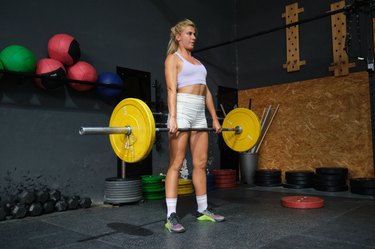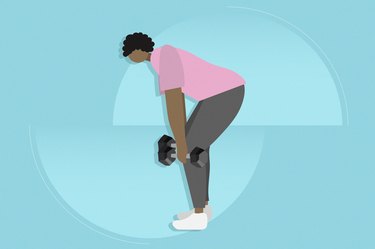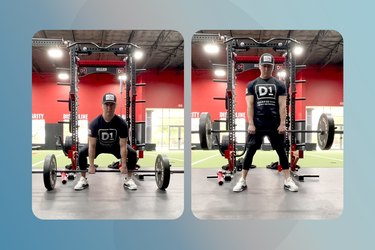

When it comes to building functional strength, few exercises are better than the deadlift. The sumo deadlift, in particular, is an excellent option for people who are tall, have lower-back issues or want to make more for their stomachs when reaching for the bar. Thanks to the more upright back positioning, it comes with all the benefits of deadlifts, and then some.
If you're looking for a way to build functional strength and muscle mass in your lower body and core, you'll want to give the sumo deadlift a try.
Video of the Day
Video of the Day
What's the Difference Between Sumo, Conventional and Romanian Deadlifts?
The sumo is one variation of the deadlift, a lower-body exercise that involves hinging from the hips and then driving through the glutes and hamstrings to lift a weight.
In it, you take a really wide stance with your toes slightly turned out, and position your arms between your legs to grab the barbell that's resting on the floor. Because of this setup, you're able to have a more upright torso, which makes the move a bit squatier than its counterparts, says Matt Kite, CSCS, a certified strength and conditioning specialist and director of education at D1 Training.
That's in contrast to both conventional and Romanian deadlifts.
Conventional: In these, you set up with a hip-width stance, toes pointing forward, and position your arms just outside of your legs. This means you have more distance to reach to grab the barbell on the floor. As a result, you have a less upright torso and a more scrunched-up posture.
Romanian: They're more similar to conventional deadlifts than to sumos. But in them, rather than starting from the floor, you start from a standing position, holding the bar in front of you against your hips. With each rep, you lower the weight just past your knees.
Sumo Deadlift vs. Deadlift Muscles Worked
“All deadlifts work the back muscles, core, hamstrings and glutes,” says Christine Torde, CPT, a strength coach at Body Space Fitness in New York City.
“In the sumo, because your legs are wide and your center of mass is a bit lower to the ground, you're also really going to feel it in your hip adductors [inner thighs] and quads.”
You're also going to put more emphasis on your glutes and entire posterior chain, Kite says.
Is the Sumo Right for You?
There are a lot of strong opinions in the sumo deadlift vs. Romanian deadlift vs. conventional deadlift, but in the end, no one variation is going to be best for everyone. The best deadlift depends on your unique body and goals.
"Many who opt for the sumo are looking to take some of the strain off the lower back while maintaining a more vertical spine position," Kite says.
This can be really useful for people who are tall or have long legs, and might have trouble reaching the barbell in a conventional deadlift without curving their back.
The sumo squat is also one of the best strength variations for plus-size athletes and people with large breasts. That's because, when you set up in a sumo stance, you don't have to get in such a scrunched thighs-to-chest posture at the bottom of each rep.
If you have a hard time comfortably reaching the bar during conventional deadlifts or doing so without arching your back, the sumo deadlift might the best deadlift variation for you.
How to Do Sumo Deadlifts With Proper Form
Sumo Deadlift
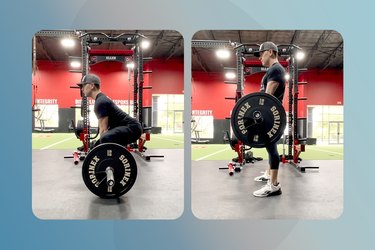
- Fix the weight plates on your barbell and position it on the floor in front of you.
- Step up with your shins almost against it, feet about double shoulder-width apart and toes angled out. Keep your spine straight, chest up and shoulders back and down.
- Grip the bar with both hands about shoulder-width apart. Tighten your glutes, legs and core to brace your body before you lift.
- Drive your feet into the ground while keeping your back flat. As you straighten your legs, you should be pulling the bar up in a smooth motion, keeping your arms extended. Don’t jerk the weight with your arms.
- As the bar rises, squeeze your glutes and think about your hips and knees extending and locking out at the top at the same time.
- Finish the move standing as tall as possible, pause, and then slowly reverse the motion to rest the bar back on the floor.
Watch the Full Sumo Deadlift Tutorial
10 Sumo Deadlift Technique Tips
1. Test Your Stance
It might feel awkward or wrong to stand with a wide stance and your feet turned out, but that stance is key to feeling the lift in the right spots.
"You won't get the right lift if you don't have the wide 'sumo' stance," Torde says. The width of your stance will vary depending on limb length and mobility, but the overall goal is to be able to keep your back flat while lowering the body and keeping the shins vertical, Kite says.
Before you lift, double-check your stance. Stand with your feet hip-width apart, and then take about 1.5 steps out in each direction. Rotate your feet out about 45 degrees.
Then, test it. Bend your knees lower your torso down, keeping your back flat and upright. If you feel like your knees can't fully bend enough for you to reach your hands to the ground, step your feet out a little more.
"It might take practice to find your sweet spot with the feet," she says.
2. Choose Your Hand Positioning
Now, grab the bar with your arms about shoulder-width apart and as vertical as possible.
You can grip the bar with an overhand grip (both palms facing down) or a mixed grip (one palm facing up, one facing down). Generally, it feels more comfortable to use an overhand grip, but a mixed grip does make it easier to hold onto the bar without your grip strength fatiguing.
If you do use a mixed grip, alternate for each set to keep things even on each hand.
3. Keep the Bar Close to Your Body
When you're doing the lift, you want the bar right up against the shins, Torde says. "It should feel like you are pulling up your pants."
If you start with the bar too far away from your body, it'll be further from your center of mass, which will make it difficult to use power during the lift. This will increase your risk of lifting incorrectly and injuring your back, she says.
Set up with the bar as close to your shins as possible, ideally right over the middle of your feet's arches.
4. Brace Your Core
Yes, the sumo is a leg and glute exercise, but if you do it right, it's also one heck of a core workout. Before you lift the weight, engage and tighten your entire core, Kite says.
You want to maintain this core engagement throughout the entire exercise until you place the weight back on the floor.
5. Pull the Slack Out of the Bar
That's just a fancy way of saying: Set up with all your muscles engaged and in the "ready" position. Make sure the bar isn't loosey goosey in the weight plates.
Once you grip onto the bar, you want to create tension in essentially every muscle in your body and slightly pull up on the bar by engaging your lats and squeezing your shoulder blades down and together. (You'll keep this tension throughout the entire exercise.)
6. Push Through Your Legs
For the greatest sumo deadlift benefits without hurting your back, you want to make sure you're pushing through your feet to drive the movement. That's right, you're using your legs to lift the bar, not your arms.
Instead of pulling the bar up with your arms, think of the arms as just the connector to the bar, Kite says. "Initiate the movement by driving your heels into the ground and driving the weight up with the legs. Your arms are just along for the ride."
Another cue: Push the floor away from you.
7. Extend Your Knees and Hips at the Same Time
A common mistake people make during the exercise is extending the legs before raising the upper torso, Kite says. This makes it so you end up using mostly back extension to finish the lift — which puts a lot of unnecessary strain on your spine.
The fix: "Think of keeping your chest up and hips extending the same speed as your legs," Kite says. If you're still having trouble with this, he recommends practicing with a lighter weight first so you can perfect the timing of your lockout before adding a challenging amount of resistance.
8. Press Your Knees Out
Your knees might feel compelled to cave in a bit as you lift. To avoid that, think about gently pressing your knees out and away from each other.
Start actively pressing them out when you're setting up, and then continue to press out as you lift. This will also help you keep your hips and knees at the correct angle and concentrate the work in your glutes.
9. Keep Your Chest Up
This simple cue can help you do two things: Keep the bar close to your body and extend your knees and hips at the same time.
If your chest is down, you're more likely to extend your hips before your knees. Keeping your chest up also ensures you're putting the weight down and back into your glutes, avoiding any temptation or urge to lift more from the lower back.
10. Time Your Breaths
There are a couple of ways to breathe when lifting weights.
Eccentric-Concentric: This is the most common breathing technique and the one that's best for the majority of lifters. With it, you inhale before your rep, exhale as you lift the weight and then inhale as you lower the weight to the floor. By exhaling through the hard, or concentric, part of the exercise, you further brace your core and transfer force.
Valsalva Maneuver: While this is a great option for advanced lifters trying to hit PRs, it's not a wise option for anyone with heart, blood pressure or fainting issues because it increases blood pressure. With it, you inhale before your rep, do a forced breath hold until you reach the top of your rep or move past the exercise's "sticking point." You then exhale and lower the weight.
A forced breath hold, aka the Valsalva maneuver, involves exhaling against a closed glottis. It's the same action you might use to pop your ears on a plane.
How Much Weight Should You Use?
Here's another sumo deadlifts benefit: With them, you can lift more weight than you can with conventional deadlifts. The extra knee bend and more upright torso put you in a "stronger" position.
That said, the most important thing with this move (and any lifting exercise, really) is that you’ve practiced proper sumo deadlift form before ever touching a weight. Going too heavy too fast is a great way to get hurt.
Even once you’ve got your technique down, starting your first set with a light weight isn’t a bad idea.
“I always recommend warming up with a few reps at a lower weight first to practice,” Torde says. That way, you can give your body and brain a few low-risk reps to remember the movement before loading it up for the main event.
No Barbell? Try the Kettlebell Sumo Deadlift
If you don't have access to or want to use a barbell, you can do the sumo deadlift with a kettlebell.
You can also use a single dumbbell, holding it vertically at one end, but trainers don't typically recommend this because it can feel a little wonky and be harder to control, especially at high weights. If that's all you've got for equipment, though, you can make it work.
KB Sumo Deadlift
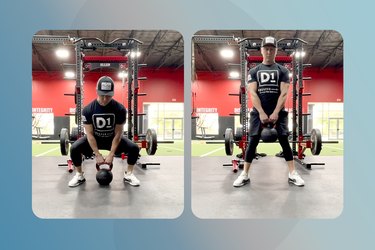
- Set up with a kettlebell on the floor between the balls of your feet, feet wider than shoulder-width apart and toes angled out. Keep your spine straight, chest up and shoulders back and down.
- Hinge at your hips and bend your knees so you can grab onto the kettlebell handle with both hands. Tighten your glutes, legs and core to brace your body before you lift.
- Drive your feet into the ground while keeping your back flat. As you straighten your legs, you should be pulling the kettlebell up in a smooth motion, keeping your arms extended. Don’t jerk the weight with your arms.
- As the weight rises, squeeze your glutes and think about your hips and knees extending and locking out at the top at the same time.
- Finish the move standing as tall as possible, pause, and then slowly reverse the motion to rest the kettlebell back on the floor.
What About the Sumo Deadlift High Pull?
The sumo deadlift high pull, or SDHP, is a CrossFit-specific exercise that involves raising a barbell from a sumo position to your chin, keeping your elbows as high as possible.
The SDHP places extreme load on the shoulders, and in an impinged position that can be harmful to the joint. Also, by including the high pull, which is similar to a vertical row, it doesn't let you maximally load the hips.
If you want to improve your triple extension — or ability to quickly straighten your ankle, knee and hip joints to vertically move loads — cleans better train the movement while also keeping the shoulder in a healthier position.
